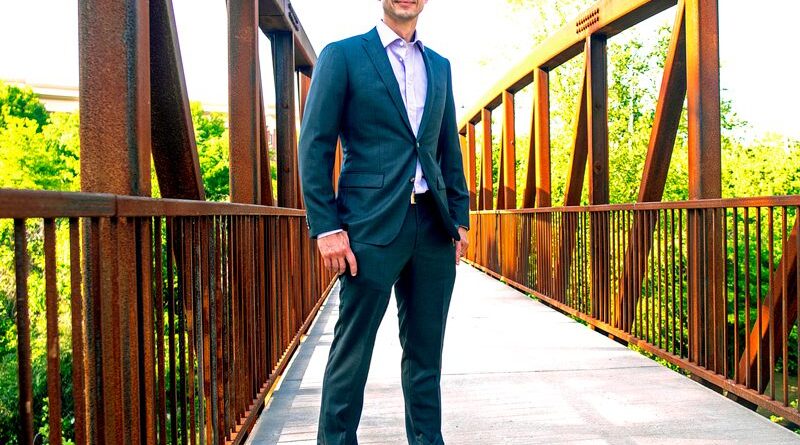AVERTING CATASTROPHE
Written by Jill Neimark
Bridges are like birds — they live on the earth and in the sky. They allow us to cross what is not crossable. They seem to defy gravity, suspended over water, gorges and ravines; and yet they can be dangerous, even deadly, when they become unstable or collapse. Igor Belykh, Distinguished University Professor of Mathematics at Georgia State University, wants to help build better bridges.
“I’ve been fascinated with bridges since I was in high school,” explains Belykh, who models the way systems move in and out of sync, from neurons to bridges to laser beams to drones. Bridges naturally vibrate all the time, absorbing energy from traffic or wind, and the lessons we learn from their behavior can help us understand deep phenomena in biology and society.
“The way bridges behave gives us important insights into resonance, which is the vibration of an object at its natural frequency,” he says. “That is a phenomenon that exists across all of nature. Bridges can help us explain how financial systems become unstable, why fireflies flash in synchrony or even how to build powerful lasers that can beam across vast distances underwater.”
Working with colleagues at the Universities of Bristol, Cambridge, and Leicester in Great Britain, Belykh has developed surprising new explanations for why some bridges wobble, as well as mathematical models that help predict the point at which a bridge might become unstable. These new models can accurately determine how many pedestrians a bridge can support before it suddenly starts to sway.
He is also working with Heriot-Watt University in Edinburgh and Georgia Institute of Technology to harvest unused energy trapped in bridges. That energy is naturally generated by the resonant low-frequency vibrations of bridges. The energy will be captured to power tiny bridge sensors that monitor the structural integrity of the bridge, as well as vibrations, traffic load, wind and temperature, and relay the information by WiFi.
![]()
Unstable bridges are a worldwide problem. Perhaps the most famous example is the Tacoma Narrows Bridge, which is suspended over Puget Sound in Washington. The original bridge opened on July 1, 1940 and tore apart a mere four months later. The winds the day it collapsed were moderate, but the bridge was unusually slender, with narrow girders, and had already been nicknamed “Galloping Gertie” because of its tendency to swing. On that fateful day, a 600-foot section broke free as the bridge surged violently. Leonard Coatsworth, a Tacoma News Tribune editor, described abandoning his car and crawling to safety on his hands and knees until they were bloody; his cocker spaniel remained in the car and died as the bridge collapsed.
“That bridge is in almost every book about physics, and every primer on math equations,” says Belykh, who first encountered a description of it as a teen. “There is still no full agreement among scientists and engineers about why it collapsed.”
But it is on the minds of everyone doing applied math or physics because it collapsed at a different frequency than the frequency of the wind that day. “That bridge was the first reason I began to think about bridge behavior.”
The Tacoma Narrows Bridge is not the only case of an unstable bridge. In San Francisco in 1987, 300,000 individuals tried to cross the Golden Gate Bridge on the structure’s 50th anniversary. The bridge wobbled so violently people panicked and threw bicycles and baby strollers off the sides. In England, in the year 2000, the London Millennium Footbridge closed only days after it opened, due to the terrifying way it rocked when people crossed. (It later reopened after the addition of large shock absorbers.) And in the high peaks of the Himalayas, where Belykh has hiked, suspension bridges made of rope and wood planks regularly rock violently.
“Those bridges are quite flexible and unstable, and they really bobble,” he says. “I’ve actually tried to measure the oscillations with my iPhone’s accelerometer.”
It was while crossing those shivering, shimmying rope bridges in the Himalayan mountains that Belykh began thinking about how humans crossing a bridge might destabilize it. For the past 20 years, engineers and scientists believed that pedestrian bridges could become unstable and even collapse due to mass synchronization of human footsteps — such as a troop of soldiers walking in lockstep, synchronized like swinging pendulums. This is called phase locking. The explanation was so widely accepted that on the Albert Bridge in London (nicknamed “The Trembling Lady”) a sign was posted instructing soldiers to break step when crossing.
Igor Belykh crossing the rope bridges in the Himalayan mountains
But Belykh had his doubts. The high altitude rope bridges in Nepal often swayed, and though the swaying was clearly due to the humans crossing on foot, those humans showed no signs of phase locking. Something else was happening. He had also noticed a similar phenomenon when climbers making their way up Mt. Everest crossed metal ladders suspended over giant crevasses. Weight mattered: when climbing the ladders with heavy backpacks, the ladders would wobble dangerously in all directions. Increased mass seemed to trigger the dangerous oscillations.
When Belykh and his colleagues took videos of trekkers crossing bridges, they saw people moving one leg and foot past the midline of the body, crossing over and back in a kind of awkward dance in an attempt to stay upright and stable. Add in a heavy backpack and the adjustments were even more extreme. Belykh thought these were powerful clues to unstable bridges around the world.
“Humans cross a bridge and it begins to wobble a tiny bit. They feel the wobble and try to adjust their steps in order not to fall over,” he explains. “But as they do so, shifting from side to side, they create even more intense vibrations.”
They are now like passengers on a boat rocking side-to-side in a stormy sea. They slow down, and at the same time try to stabilize their gait. If enough people are crossing by foot that way, their combined weight and movement can destabilize the bridge. Scientists have a name for this effect. It’s called negative damping, and occurs when an external system continually pumps energy into an oscillating object.
“The code for designing pedestrian bridges in the United States does not have explicit guidelines to account for crowd dynamics,” says Belykh. In 2017, Belykh and his colleagues published work determining the exact number of pedestrians — 165 — that could cause the Millennium bridge to suddenly sway.
More recently, in 2021, they analyzed data from 30 different bridges around the world, applying differential equations to predict the point at which a bridge might become unstable. They also created computer models of humans walking on bridges — which the team called crash test dummies — that can be used to test a specific bridge design. Engineers can use these formulas to design and build safer bridges.
UNSTABLE BRIDGES OF THE PAST
The most famous example of an unstable bridge is the Tacoma Narrows Bridge, which is suspended over Puget Sound in Washington. The original bridge opened on July 1, 1940 and tore apart a mere four months later.
In San Francisco in 1987, 300,000 individuals tried to cross the Golden Gate Bridge on the structure’s 50th anniversary. The bridge wobbled so violently people panicked and threw bicycles and baby strollers off the sides.
In England, in the year 2000, the London Millennium Footbridge closed only days after it opened, due to the terrifying way it rocked when people crossed. (It later reopened after the addition of large shock absorbers.)
The Albert Bridge in London (nicknamed “The Trembling Lady”) was forced to post a sign instructing soldiers to break step when crossing. This is to prevent crowd-induced bridge instability.
![]()
Belykh says he was destined to be a mathematician. He grew up in Nizhny Novgorod (formerly Gorky), a Russian city famed around the world for a school specializing in nonlinear dynamics, including phenomena such as resonance. Equally inescapable was his brilliant father, Vladimir, a storied mathematician who developed a map named after him that is used to study complex systems. The two, father and son, have even collaborated on papers together.
Perhaps as a counterpoint and relief from mathematics, Belykh has participated in extreme sports his whole life. “I’ve paddled some of Europe’s and Asia’s most dangerous whitewater rivers, gone on a ski expedition in the polar region, and climbed the main peaks in the Alps. I’ve been a boxer, and I have all the gear to climb Mt. Everest in my basement, including an ice axe and plastic boots. I hope to climb it someday.” He says for now, his wife has asked that he wait until their sons are grown, and he has agreed.
“Math and extreme sports present the same challenge to me,” he explains. “I want to see if I have the guts to step into the unknown. Whether it’s a mountain or math research at a high level, you never know whether you will succeed or fail.”
The insights Belykh has gained from bridges inform much of his other work and have led to collaborations with physicists and engineers here and abroad. When pedestrians lift their feet up and down, they transfer their energy into a bridge. They are “coupled” to the structure. Coupling occurs in many physical and biological systems. Heartbeats, the singing of crickets, the flashing of fireflies, computer switches, and the entire power grid of the United States oscillate off and on, ultimately synchronizing into congruity.
It turns out that the inherent asymmetry in many instances of coupling can lead to a more powerful coherence. “It sounds a bit crazy,” says Belykh, “but pedestrians of different sizes and masses can shake a bridge more powerfully than identical pedestrians. The asymmetry generated by the random motion of pedestrians creates a stronger force.”
He is now applying that insight to the construction of enormous lasers, in collaboration with physicist Adilson Motter of Northwestern University and Yehuda Braiman, a specialist in photonics and optics at the University of Central Florida. “Igor is one of the rare people who is very mathematically rigorous but at same time has an extraordinarily good sense of how to select problems to work on that have practical significance in this world,” says Motter.
The team’s goal is to build large lasers by joining multiple small, inexpensive laser devices. They have received an initial $780,000 grant from the United States Office of Naval Research to support their work.
“Just think of a laser pointer,” explains Belykh. “It’s a very cheap device, and needs very little power. But imagine if I have a million laser pointers, and I can synchronize all their beams, much like pedestrians on a bridge.”
Small lasers are never identical — just like pedestrians — so they can’t simply be joined to create a consistent, large beam. Belykh hopes to develop mathematical formulas that actually build on that imprecision, and thus create a huge powerful laser that might have nautical and military applications.
Igor Belykh on top of Mt. Kilimanjaro honoring his collaborator, John Macdonald, a professor of bridge engineering who passed away unexpectedly in March 2022
Belykh is also working with Maurizio Porfiri, professor of engineering at New York University, to study systems that switch or “blink” off and on. As an example, a small group of neurons exhibiting seizure-like spurts of electricity can spread across the whole interconnected network of the brain and induce a body-wide seizure. The scientists hope to apply their work to drones that guide the behavior of other drones by sending out off-and-on signals.
“We’ve found that the rate of switching off and on matters,” says Belykh. “It can’t be too fast or too slow to strike the perfect balance between drones’ coordination and energy efficient communication.”
“Igor and I have become very good friends, and I learn so much from him” says Porfiri, who recalls the first time they met at a conference in 2006. Porfiri had just presented a paper when “a very tall, imposing, muscular man stood up, with a thick accent not unlike mine, and asked a brilliant question.”
Belykh says he loves to collaborate. “Just as you need partners when you climb mountains, you need collaborators in science. Not only is it fun, but you can also achieve much more together.”
Next up? He hopes to return to the long, trembling rope bridges pinned high in the Himalayas to precisely measure changes in the vibration of the structures as pedestrians cross. And he’s working on a more accurate explanation for the collapse of the Tacoma Narrows Bridge.
“Solving that puzzle will be like climbing Mount Everest.”
Top Photo by Steven Thackston












Leave a Reply